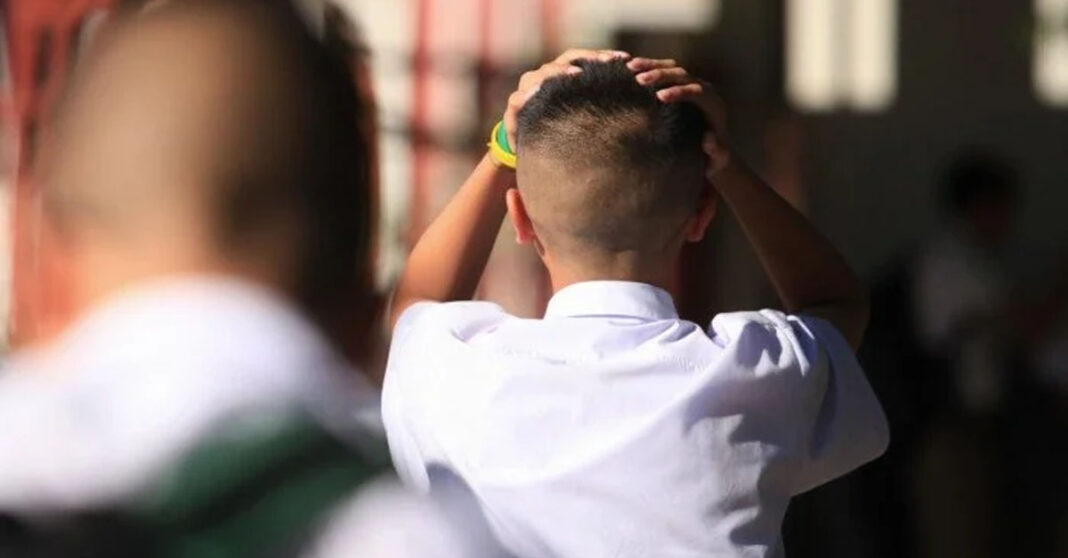Social media has recently ignited a fiery debate surrounding the disciplinary practices in schools, particularly those overseen by the state and located in rural areas across Laos. These practices, frequently viewed as outdated and inappropriate, have come under intense public scrutiny, exposing a clear division of opinions. While some condemn these disciplinary measures, others place the blame on students for not adhering to established rules.
The range of punishments, from forcibly shaving students’ hair due to its length, denying late students entry to the school building for extended periods, to assigning children the task of cleaning school walls in sweltering conditions, has emerged as a prominent online discourse in recent days following the circulation of photos and videos depicting students subjected to these penalties.
Online reactions to these posts have been mixed, with many expressing disagreement with the approaches adopted by teachers to discipline their “misbehaving students,” arguing that such practices are narrow-minded and outdated.
“Cutting or shaving students’ hair does very little to nothing in improving children’s discipline. In return, punishments like this only bring them shame and embarrassment,“ said a Facebook user, who explained that hair shaving contributes nothing to bettering students’ behaviors but provokes further delinquency in response to perceived injustice.
One user recounted the story of his teenage years when their hair was abruptly cut without warning after dyeing it during the New Year break.
“I dyed my hair during the new year, something many teenagers do, and when I went back to school after a long holiday, the teacher grabbed a huge portion of my bangs and cut them; it was an experience I will never forget.”
Another user pointed out that some teachers resort to unreasonable punishments fueled by their bitterness and inferiority complex. “They simply just want to take out their insecurities and frustration on students,” they commented.
“If something, such as cutting students’ hair or having them do outdoor cleaning under the hot sun, were to happen in Western countries, the educators would instantly lose their job,” the user added, outlining the disparity between Laos and other regions of the world when it comes to discipline.
Despite a number of negative comments condemning Lao teachers for clinging to outdated practices, another group of users expressed support for the punishments, with some arguing that rule breakers deserve the consequences they receive.
A Facebook user who identified themselves as a teacher on their profile, defended the practice of shaving students’ hair, stating, “Well, we’ve warned them not just once but twice to cut their hair, and no actions have been taken, so we had no choice but to take extreme measures.”
A board director of a private school, who wished to remain anonymous, spoke to the Laotian Times about hairstyle regulations, explaining that each school has its own approach to the issue.
“Private schools, like ours, tend to be more flexible with this rule. We allow male students to have certain hairstyles that government schools might not permit, as long as they are not excessively long or messy,” said the board director.
However, she noted that not all private schools are as lenient, as some still adhere strictly to the old culture, which includes male students having extremely short hair to almost baldness and not allowing female students to let their hair down or have bangs.
The board director also acknowledged that incidents of teachers taking matters into their own hands and cutting students’ hair still occur. While her school does not condone such actions, she understands the frustrations that may lead to them.
“Perhaps the teachers who resort to such punishments are frustrated that the students did not comply with the hair rules as instructed. Some teachers see disobedience as a challenge, which can be upsetting for them.”
As a private school’s board director, she emphasized the importance of direct communication with students about the rules and listening to their perspectives to foster understanding.
“Communication is key, even between teachers and students. If the issue persists, our disciplinary measures include reducing their grades, contacting their parents, and assigning them creative tasks to help them understand the importance of following rules.”
The practice of dictating students’ hairstyles is not unique to Laos; controversies over this issue are also widespread in Thailand. In 2022, more than 60 high school male students in Phatthalung Province, Thailand, were denied entry to an examination room because their hair was longer than the school’s rules allowed.
In another incident that same year, a teacher cut a female student’s hair because it was “too long.” But despite promising to only cut a few strands as punishment, the teacher ended up cutting a large portion of the student’s hair.
These incidents sparked significant controversy in Thai communities. While some argued that students should adhere to their school’s rules, many cited regulations issued by Thailand’s Ministry of Education regarding students’ hairstyles.
According to these regulations, in Thailand, male students can have either short or long hair. If their hair is long, it must not extend past the bottom of the hair on the sides and back of the head, and the front and top of the head should be kept neat. Female students are also allowed to have short or long hair, which should be kept neat and tied back appropriately if long.
The regulations also prohibit hair perming, dyeing hair in a different color than its natural one, growing mustaches or beards, and any other actions deemed inappropriate for students.
The culture of cutting students’ hair and other punishments involving their appearance and physique remains a controversial topic in Laos. While some advocate for more creative disciplinary measures that do not cause embarrassment, others believe that these practices are appropriate and should continue as part of the local cultural tradition.



